|
Additional Lessons |
 About These
Lessons About These
Lessons
The following classroom lessons are great for students
who want additional listening and reading practice. |
-
Travel America -
Beginner
Level. Do you love America and American
English? Learn before you travel. Facts and other
cool stuff about your favorite U.S. state. Great
English reading practice.
|
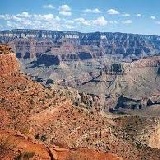 Travel
America - Missouri Travel
America - Missouri
(Beginner -
Reading)
Learn some interesting facts and read interesting
stories about Missouri. |
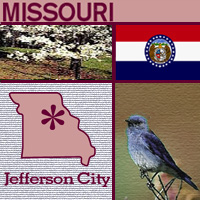 Missouri Missouri
Missouri is called the "Show Me State," because its
people have a reputation for believing only what
they see. Its name is an Algonquin Indian term
meaning "river of the big canoes." Originally home
to a number of Indian tribes, the state entered the
Union in 1821. Today, more than half the population
lives in Missouri's two major cities--Kansas City
and St. Louis. The dogwood is the state tree, the
bluebird is the state bird and the capital is
Jefferson City. |
Missouri
State Flag
The Missouri state flag was officially approved in
1913. The original flag (designed and created by Marie
Elizabeth Oliver) is on display at the Secretary of State's
office in Jefferson City, Missouri.
The stripes on the flag are symbols for bravery (red
stripe), purity (white stripe), and justice (blue stripe).
The center of the flag displays Missouri's state seal
surrounded by 24 stars (Missouri became the 24th state on
August 10, 1821 (although the Roman numerals at the bottom
of the seal that acknowledge this date read 1820:
"MDCCCXX"). All Dates of Statehood
The two grizzly bears are symbols of courage and strength.
They stand on a scroll bearing the state motto: Salus Populi
Suprema Lex Esto (Latin for "Let the welfare of the people
be the supreme law").
The bears support a shield encircled by the motto: "United
We Stand, Divided We Fall (indicating Missouri's advantage
as a member of the United States). The shield displays the
U.S. coat of arms on the right (a bald eagle clutching
arrows and olive branches), and a grizzly bear and crescent
moon on the left.
The crescent moon is a symbol that represents Missouri when
the state seal was created in 1822 - a state of small
population and wealth which would increase like the new or
crescent moon. The crescent moon also symbolizes the "second
son" (meaning Missouri was the second state formed out of
the Louisiana Territory).
Above the shield is a helmet representing Missouri's state
sovereignty. The large star above the helmet surrounded by
23 smaller stars represents Missouri's status as the 24th
state. The cloud around the stars indicates the problems
Missouri had in becoming a state. |
|
Source:
State Symbols USA |
|
|
 Missouri
State Facts Missouri
State Facts
Picture: state seal of Missouri |
|
State Capital |
Jefferson City |
|
Nickname |
Show Me State |
|
Motto |
Salus Populi Suprema Lex Esto (The Welfare of the
People Shall Be the Supreme Law) |
|
Statehood |
August 10, 1821 (24th) |
|
Origin of Name |
Named after Algonquin Indian term meaning "river of
the big canoes." |
|
Largest Cities |
Kansas City, Saint Louis, Springfield, Independence,
Columbia |
|
Border States |
Arkansas, Illinois, Iowa, Kansas, Kentucky,
Nebraska, Oklahoma, Tennessee |
|
Area |
68,898 sq. mi., 18th largest |
|
State Bird |
Bluebird |
|
State Flower |
Hawthorn (crataegus) |
|
State Tree |
American Dogwood (cornus florida) |
|
State Song |
Missouri Waltz |
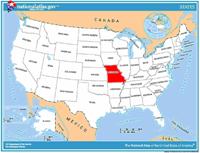 Travel and tourism site
for Missouri - This state travel and territorial
tourism site provides ideas for your vacations, meetings, and more. Travel and tourism site
for Missouri - This state travel and territorial
tourism site provides ideas for your vacations, meetings, and more. |
|
|
Missouri Stories |
|
|
The Annual American Royal:
BBQ, Horse Shows and Cattle
Would you like to take part in a rodeo? If so, then
the annual American Royal Livestock, Horse Show and
Rodeo is the one for you. The Children's Rodeo is
just one of many fun things to do at this event that
celebrates the importance of livestock to Kansas
City, Missouri.
The American Royal Livestock, Horse Show and Rodeo
began as a cattle show in a tent at the Kansas City
Stockyards in 1899. Today it is one of the Midwest's
biggest annual autumn events. There are horse and
livestock competitions and one of America's best
rodeos.
The American Royal Rodeo invites the best cowboys
and cowgirls from across the country to participate
in its competition. Plus, there's a barbecue
cook-off, featuring some of Kansas City's best
grillmasters. The city is famous for its barbecue
restaurants, which take big hunks of beef and slowly
cook them over wood or charcoal. When you go to the
Rodeo you get a real taste of life in the Midwest. |
|
|
Scientific Creativity: The
Legacy of Science Education in Southwest Missouri
Although the famous scientist Madame Curie was a
woman, girls have not always been encouraged to
study science and math. But that is changing.
Expanding Your Horizons in Science and Mathematics
is a program of the Math/Science Network conference
held in southwest Missouri. This conference helps to
encourage girls' interest in science and math and
urges them to consider careers in engineering,
computer science, and biology. About 200 to 500
girls attend this conference. There are a variety of
workshops led by women scientists, mathematicians,
and engineers.
Workshops include activities such as learning about
light, vision, and the chemistry of colors while
doing experiments. Another workshop teaches how toys
work by allowing students to take some toys apart.
They learn about magnets, electricity, and air
pressure as they are used in toys, and they get to
make their own toys to take home. Origami (the art
of paper-folding) is used to teach math concepts as
students fold paper into models and geometric
designs. In other workshops, students learn how to
make robots, how to take apart and put together
computers, and how to make a Web page. |
|
|
Max Hunter Collection
Without people like Max Hunter, important pieces of
our nation's history would be lost. He alone
preserved more than 20 years of music and folk
stories from people in the Ozarks. Can you guess how
he did it?
Hunter was a traveling salesman from Springfield,
Missouri, who went into the hills and backwoods of
the Ozark Mountains. He took a reel-to-reel tape
recorder with him to record folk songs and stories
of the people in this remote area. Thanks to him,
1,600 Ozark Mountain folk songs, recorded between
1956 and 1972, are available for listening at the
Springfield-Greene County Library in Springfield,
Missouri.
It was a good thing that Hunter recorded these folk
tales and songs when he did, because once radio and
TV became popular, people in the Ozarks stopped
sitting on their porches entertaining themselves
with stories and music. Many patterns of Ozark life
would have been lost.
Can you imagine what listening to these songs will
tell you about life in the Ozarks that you won't
find in a history book? |
|
|
Pony Express
Nowadays, it takes only a few days for a letter to
travel from coast to coast, and you can send an
e-mail in seconds. But in the mid-19th century, it
took six months for a letter to travel from
Washington, D.C., to California!
As the United States expanded to the West Coast,
communication became very important to the success
of the nation and its Western pioneers. The country
needed a speedy way to send messages. As a result,
the Pony Express was born.
In April 1860, 75 young men were hired and 100
horses were purchased to carry mail on horseback
from Pony Express headquarters in the Patee House
hotel, in St. Joseph, Missouri, to California. The
cost to have the Pony Express carry one letter,
which took 10 days, from Missouri to California was
$5. Today, that $5 is worth about $90! Can you
imagine spending $90 to send a letter?
By October 1861, however, the Pony Express was
extinct. The telegraph could send messages much
cheaper and faster, and, by 1869, railroads
stretched from coast to coast. Today, you can visit
the Patee House, which is now a museum dedicated to
the history of the Pony Express. The building is a
National Historic Landmark. |
|
|
Versailles Old Tyme Apple
Festival
You have probably heard the expression "An apple a
day keeps the doctor away." But apples are more than
just a healthy food. In fact, people love apples so
much that in Missouri there is an entire festival
dedicated to them.
The first Old Tyme Apple Festival in Versailles,
Missouri, was held in 1980. It included an antiques
auction, a dramatic presentation on the courthouse
steps, a bareback riding marathon, craft and food
vendors, and many contests, including apple-peeling,
nail-driving, log-sawing, face-painting and
bubble-gum blowing.
Today, if you go to the Old Tyme Apple Festival you
can have lots of fun talking to Mickey and Minnie
Mouse, seeing puppet shows, taking a pony ride or
watching a parade, where you just might see "Smilin'
Joe" on his mechanical horse. |
|
|
St. Louis, Missouri, Home of
the First Ice Cream Cone
Do you love ice cream? How about an ice cream cone?
Did you know that the first cone was introduced at
the St. Louis World's Fair in 1904? Children who
attended the fair were the first ones in the world
to eat this delicious treat.
The story goes that when the ice cream vendor ran
out of paper cups and spoons, he put the ice cream
in a rolled up waffle that the man in the next booth
was selling -- and an invention was born -- by
accident!
How do you like your ice cream cone? With lots of
toppings? |
|
|
National Tom Sawyer Days
What do Tom Sawyer and jumping frogs have in common?
Stories about both of them were created by one man:
Mark Twain. Born Samuel Clemens (Mark Twain was his
pen name), Twain was 4 when his family moved to
Hannibal, Missouri, located on the west bank of the
Mississippi. Twain grew up there and was fascinated
with life along the river -- the steamboats, the
giant lumber rafts, and the people who worked on
them.
"The Celebrated Jumping Frog of Calaveras County" is
one of Twain's best-loved short stories, and The
Adventures of Tom Sawyer is one of his most famous
novels. Both these works are celebrated by events
held during National Tom Sawyer Days every fourth of
July. The boy in the photo entered his frog in the
jumping contest. There's also a fence-painting
contest to see who can paint the fastest. The idea
for this contest comes from a scene in Tom Sawyer,
in which Tom has been told to paint the fence in
front of the house he lives in. It's a beautiful
day, and he would rather be doing anything else. As
his friends walk by, he convinces them it's fun to
paint, and they join in the "fun." By the end of the
day, the fence has three coats of paint!
Although the story of Tom Sawyer is fiction, it's
based on fact. If you go to Hannibal, you'll see the
white fence, which still stands at Twain's boyhood
home. |
|
Source:
Library of Congress |
|
 National
Forests, Parks, and Monuments of Missouri National
Forests, Parks, and Monuments of Missouri
The following is a description of national
forests, parks, and monuments in the state
of Missouri. If you plan to visit or live in
Missouri for awhile then you should
definitely plan to visit some of these
fantastic places. |
|
|
|
National Forests |
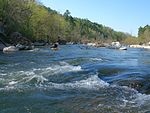 Mark
Twain Mark
Twain
Missouri's only National Forest, Mark Twain
contains seven wilderness areas and the
Eleven Point National Wild and Scenic River.
There are 19 natural areas in the forest
that are managed by the Missouri Department
of Conservation. |
|
|
|
National Parks |
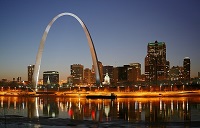 Gateway
Arch Gateway
Arch
The Gateway Arch is a 630-foot (192 m) (both
high and wide) catenary arch built to
commemorate the Lewis and Clark Expedition,
initiated by Thomas Jefferson, and the
subsequent westward expansion of the
country. The nearby Old Courthouse, across a
greenway to the west of the arch, was the
first site of the Dred Scott case about
slavery. A museum, located in the
underground visitor center below the arch,
describes the arch's construction and the
country's westward expansion. |
|
|
|
National Monuments |
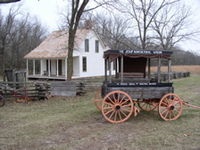 George
Washington Carver George
Washington Carver
The site preserves Moses Carver's farm,
which was the boyhood home of George
Washington Carver, a scientist and educator
who developed many uses for peanuts. It was
the first national monument dedicated to an
African-American and first to a
non-president. |
|
|
|
 Travel
America Travel
America
Do you love America and American English? Learn before
you travel. Facts and other cool stuff about your
favorite U.S. state. Visit the Fun Easy English Travel
America pages. Read about the beautiful National
Forests, Parks, and Monuments. Great English reading practice. |
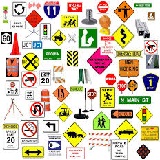 Drive America Drive America
Planning to drive in America? Learn the rules and
regulations. Great English reading practice. |
|